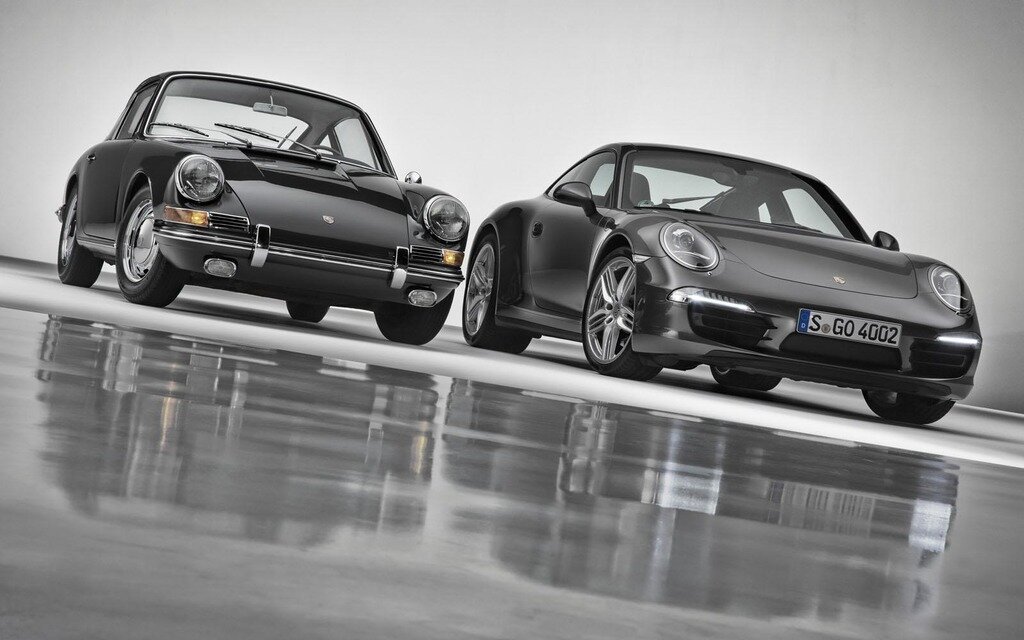Porsche’s from Ashes to Pop Culture | Part 3
911 Porsche Side by Side showcasing 50th Anniversary
By: Daniella J Enriquez
Last time we began discussing the history of the Porsche brand in the US and the man behind its humble beginnings, Mr. Max Hoffman. This week, we will be diving deeper into how Porsche became a renowned car brand in the United States and their explosive rise in popularity to become an icon of the auto industry.
Porsche 356 SL at Le Mans, Circa 1951
In the last blog we discussed how Hoffman Motor Company introduced Porsche in the U.S. Car aficionados drove from all over the U.S. to Hoffman’s showroom to purchase a Porsche catapulting the company into stardom and beginning their expansion into other dealerships around the country. By the 1960s, more than half of the Porsches produced were sold to consumers in the U.S. market. Both male and female drivers were interested in purchasing Porsches as racing vehicles due to their powerful engines, agile handling, and lightweight bodies. Ruth Levy Raymond famously raced a Porsche 356 Speedster in Southern California which she purchased from the Hoffman Motor Company Showroom in New York. John von Neumann, owner of Competition Motors in North Hollywood, originally bought a Porsche from Hoffman to race and then went on to sell the vehicles within his own showroom.
Porsche 356 Speedster Racing
After Porsche’s expansion into dealerships around the U.S.; the company began expanding into motorsport. However, over the years many people question why Porsche is not currently involved in famous competitions like Formula 1 & Indycar. Little do they know, Porsche competed in F1 between 1957 to 1964. However, throughout those seven years the racing team only secured one win in 1962 with driver Dan Gurney. After their lackluster performance, the company left the F1 circuit entirely considering the investment too much for a team not rendering positive results. In the 80s, Porsche tried to integrate themselves into Indycar racing, but the turbo installed into their vehicle was considered too powerful, breaking records during testing and prompting an investigation. The officials demanded the turbo be lowered leading to a strained relationship between Porsche and Interscope Racing. Ultimately, Porsche departed from Indycar altogether and never raced their prototype model.
Unlike their stints at F1 and Indycar, Porsche had more success at Le Mans. Porsche’s first appearance at the event occurred on June 23, 1951, with a Gmünd SL 356. A fact few know about early Porsche race cars is the reasoning behind the black tape over their headlights. This was actually meant to help keep the headlight stable in case of a crack since early headlights were made of glass. The tape would prevent minor cracks in the lights from dropping debris on the racing tracks. Some even had wire covers to catch the debris from the cracked headlights.
Porsche Club of America Congregation
The Porsche Club of America (PCA) had its humble beginnings in the 1950s, when Bill Sholar, a commercial artist in Washington D.C., held the first unofficial meeting in his house on February 8, 1955. The August 1955 Sports Car Illustrated Magazine Issue included a brief paragraph informing the public of the PCA being developed. The first 12 club members referred to themselves as the “Gripe Group”. Together they developed a Porsche magazine and in time the club saw astronomical growth in numbers with communities outside the D.C. area developing their own sectors of the club. The Porsche Club magazine shared news of upcoming events, new model releases, technical information and much more. Through the years the club has sponsored parades, excursions to the Porsche Stuttgart factory, competitive friendly races, and much more. Today, PCA is the only car club closely affiliated with any car manufacturer worldwide. Porsche even celebrated their 70 Year Anniversary of the club with a special edition PCA GT3 Cup car.
1970 Porsche 914
Porsche has always been known for their unique designs. The Porsche 911 Targa – first introduced in 1965 – became the first Porsche equipped with a fixed safety roll bar. It was developed for the U.S. market in response to increased safety requirements for open top automobiles. This led to the development of a unique aluminum colored roll bar. Today’s 911 Targas have remained true to their original design, still equipped with the same aluminum safety.
During the 1970s, Porsche teamed up with Volkswagen to develop the Porsche 914, or the VW Porsche. The 914 was developed to be a more affordable Porsche or a modern Volkswagen, marketed specifically to customers looking for a fancy “transition” vehicle before they could afford their prized 911 or other luxury model. The 914 was sold from Volkswagen showrooms, causing confusion to the public of a possible merger. Today, Porsche is targeting the newest automotive sector, electric power. Porsche currently has two hybrid models the Panamera and the Cayenne along with a fully electric Taycan lineup consisting of about ten different model versions including a GT.
Porsche Collage
Porsche has grown exponentially since their beginnings in a small factory in Germany. Ferdinand & Ferry Porsche could not have imagined the worldwide success their automobile company has been able to achieve and the significance of the brand in pop culture. Porsche has not only become a household name, but cemented its place amongst other automotive greats as the car to own for an authentic and satisfying motor experience.
Porsche 356 Speedster
“Porsche. There is no substitute.” - Ferdinand Porsche
Porsche From Ashes to Pop Culture !







